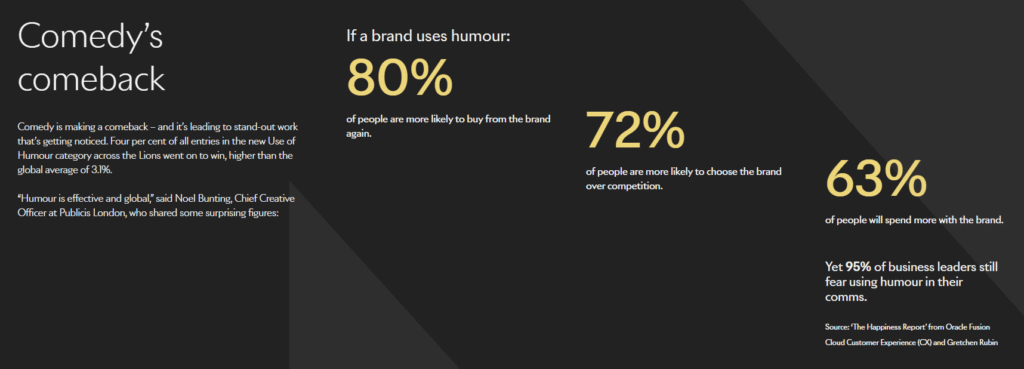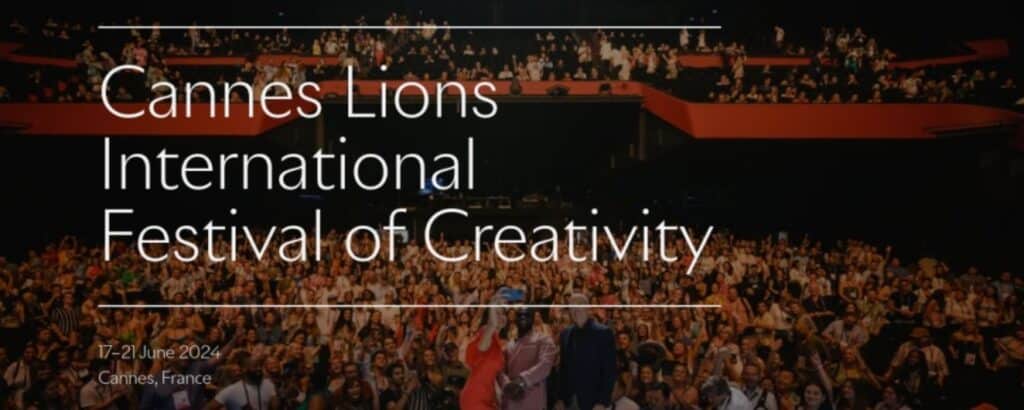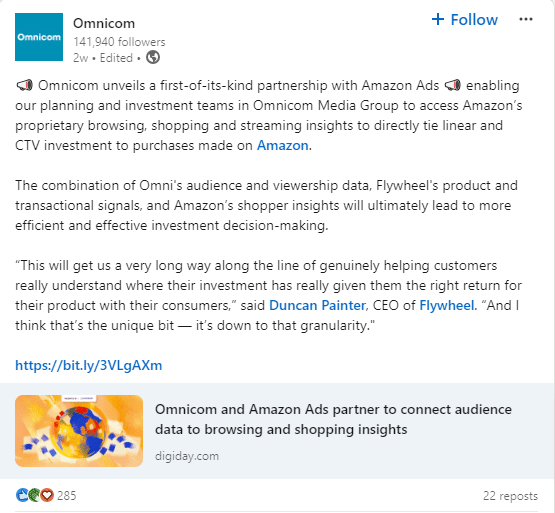I’m really excited to share my thoughts on Cannes Lions 2024, one of the most important events for us, marketing professionals. The Cannes Lions International Festival of Creativity is the Oscars of the advertising world. Held annually in Cannes, France, it’s where the industry’s best meet to celebrate, inspire, and redefine the limits of creativity.
With lots of award categories like Film, Digital Craft, Innovation, and more, the festival celebrates great work in many areas. A single campaign can even win multiple awards.
One thing that stood out at this year’s event was that humanity and humor proved to be essential in cutting-edge creativity. While AI’s role is growing, the festival showcased a strong commitment to problem-solving and impactful innovation through creative ideas. Which was evident across the stages and Grand Prix winners.
Additionally, the event spotlighted the importance of diversity and inclusion as fundamental pillars of innovation. The festival showed how diverse perspectives and inclusive practices can drive more impactful creative work.
In this article, we’ll explore key trends and innovations that emerged from the festival, providing insights to inform and inspire your next big campaign. Let’s dive in!
- Key Trends and Innovations
- Talent and Culture
- Creative Excellence
- Award-Winning Campaigns
- Future of Advertising and Marketing
- Opportunities and Challenges
- Conclusion
Key Trends and Innovations
Artificial Intelligence in Advertising
This year, as we expected, AI took center stage at Cannes Lions. Generative AI is revolutionizing how campaigns are crafted, bringing a new level of creativity and efficiency. Imagine creating personalized ads in real-time, customized to individual preferences. That’s the power of AI!
Generative AI is transforming the way brands interact with their audiences. By analyzing huge amounts of data, AI can predict trends and create highly relevant content that connects with specific audiences. This technology is also changing how people search for and interact with content.
AI is already playing a bigger role in creativity: it was used in 12% of all entries submitted this year. However, the innovation seen at the Festival was still human-inspired, highlighting the synergy between technology and human creativity. As Mira Murati, CTO at OpenAI, noted, AI is becoming more accessible through intuitively designed tools that don’t require specialized skills. She emphasized that “the technology comes to you.”
Examples and Case Studies:
- OpenAI’s Innovations: OpenAI demonstrated its latest AI tools that help brands create personalized content more efficiently. Murati also emphasized the importance of this development, stating: “It’s a ‘shared responsibility’ in figuring out how the technology comes into the real world. Even when we think about job displacement or how we elevate certain skills, roles, that’s quite dependent on how we shape the technology and the way we shape it will shape our society. I don’t see [it] as a predetermined outcome.”

- Spotify’s Innovation: There were great examples of brands innovating with familiar tools and channels. However, one that caught my attention for its innovation and creativity was Spotify. Spotify won the Digital Craft Lions Grand Prix with ‘Spreadbeats’, the first music video to be coded and experienced within, guess what, an Excel spreadsheet! Yes, you read it right… Innovations like this open doors to infinite possibilities, including considering Spotify as a video platform (videos are everywhere!).
AI is beyond automation; it’s about how you can use it with creativity. We know that AI can analyze huge amounts of data to predict trends and create content that connects with specific audiences. However, there’s concern that the democratization of tech tools like ChatGPT and Midjourney will lead to what Jeriad Zoghby, Chief Commerce Strategy Officer at Interpublic Group, called “enhanced mediocrity.” He noted, “Without differentiation, the competitive middle is starting to swell”.
Elon Musk, CTO of X (for me, always Twitter!), offered some advice: “This is the most interesting time in all of history. So enjoy the ride.”
As well said by Alexander Chen, Director of Creative Lab at Google:
“When we build AI responsibly, it’s a powerful anabler that expands our possibilities and potential… No matter how much AI improves, it is not a marketer. It does not have taste. It does not have ingenuity. That’s why sets you apart.”
– Alexander Chen – Director, Creative Labs at Google
Data-Driven Marketing
We all know that, more than ever, data is gold. First-party data, collected directly from your audience, provides deeper insights into consumer behavior. This year, the focus was on taking this data to drive smarter marketing strategies.
With Google planning to phase out third-party cookies by 2025, marketers are looking for alternatives to gather and utilize data effectively and ethically. Apple’s privacy updates, such as App Tracking Transparency, are pushing marketers to adapt. These changes require brands to find new ways to collect and use data responsibly while respecting user privacy.
First-party data allows brands to really ‘read their audience’s minds’! Providing deeper customer insights and leading to more personalized and effective campaigns. Experian highlighted that campaigns leveraging first-party data significantly boost ROI and customer engagement.
As Denise Persson, CMO at Snowflake, put it, “Marketing has always been all about, how do I continue to optimize and how can I do more with less? AI will be big for these use cases.”

Collaborations and Partnerships
Strategic collaborations were a highlight at Cannes Lions 2024, with numerous partnerships announced that promise to drive innovation and growth in the advertising industry. These partnerships occurred in different areas, from technological advancements to creative content development.
One significant partnership that stood out was between Omnicom and Amazon Ads. This duo is combining their strengths to integrate Amazon’s ad tech into Omnicom’s platform, increasing data connectivity and insights for better targeting and personalization.
A fun and creative example was the ‘Michael CeraVe’ campaign. This Grand Prix winner in the Social & Influencer category started as a joke on Reddit, linking actor Michael Cera to the skincare brand because their names sound similar. The playful campaign took off on social media, blending humor and creativity to generate buzz and engagement. The perfect blend!
Besides bringing innovation and growth (and laughs!), these kinds of partnerships can also transform the entire advertising industry. Imagine the possibilities…
Talent and Culture
The importance of diversity in a team was a major focus at Cannes Lions 2024. Nick Law, Creative Chairperson at Accenture Song, said that creativity “requires more than just one way of thinking” and offered some interesting advice for building a strong creative culture: “work with freaks, make scary stuff, and have some bloody fun.”
It’s not that difficult to find marketing professionals with inflated egos. But don’t fall into that trap! In any collaboration, trust is fundamental. As Kika Douglas Castroviejo, Chief Creative Officer of 180 Global, wisely observed, “creating without ego” is crucial as it “widens your aperture of understanding”.
The case of Renault’s double Grand Prix winner ‘Renault – Cars to Work’ was highlighted as a great example. Amy Lanzi, CEO at Creative Commerce Lions, praised it, saying, “The Jury was profoundly impressed by Renault’s innovative approach to solving genuine human dilemmas and pain points, while simultaneously driving business sales.”
Realizing that creative talent can come from anywhere opens up new levels of inclusion and brings in diverse perspectives. “You are what makes companies human, what makes brands human,” said Unilever’s Chief Growth and Marketing Officer, Esi Eggleston Bracey. So true!
Some brands are getting in on this, revolutionizing recruitment by changing outdated perceptions. Take Heineken’s ‘Bar Experience,’ as an example. This Gold PR Lion winner turned hospitality jobs from dead-end gigs into valuable, formative experiences.

Another case that caught my attention was McDonald’s Japan. They won the Gold Social & Influencer Lions with the campaign ‘No Smiles,’ where they encouraged employees to be their true selves at work.
Creative Excellence
“Even when you have AI in the mix, the heart of the creative process is still people,” said Vidhya Srinivasan, Google’s VP and General Manager of Advertising. It’s not only about storytelling. This is an important ingredient, of course! And it can (and should!) be combined with a lot of traditional techniques like illustration, stop-motion animation, and so on.
One example that also caught my attention was the collaboration between LOEWE and Suna Fujita, which resulted in a 35% increase in revenue.
Another piece that couldn’t be out from this article was the Film Craft Lions Grand Prix winner ‘The Square Meter.’
Going deep into your story before crafting it is key. As Alexander Schill from Serviceplan Group put it, “Go really deep into what you want to tell before crafting the shit out of it.” Respecting culture helps shape these stories, like in Unilever’s ‘Transition Body Lotion’ campaign.
Simplicity is crucial. It’s about your approach too. As a photographer (in my free time!) I couldn’t agree more with Riccardo Fregoso from Dentsu Creative who said, “The moment you reduce the possibilities, you start to focus.”
Award-Winning Campaigns
Among this year’s winners, it was tough to decide which ones to highlight here… But after some thought, I chose the campaigns that touched me (and I hope they inspire you as well!). They stood out for their creativity, innovation, and understanding of their clients’ needs while making the world a better place.
Coca-Cola’s “Thanks for Coke-Creating”:
Won the Gold Lion for its collaborative campaign, proving the power of user-generated content and community engagement. This campaign grabbed attention and sparked conversations, perfectly aligning with Coca-Cola’s commitment to innovation.

Heinz’s “A.I. Ketchup”:
This Creative Effectiveness Grand Prix winner had a fun twist. Heinz had asked people worldwide to draw ketchup, and they all drew Heinz. This year, they asked AI to draw ketchup, and guess what? The AI drew Heinz too! Through humor, they showed that even AI knows Heinz is the real deal. Good catch!

KPN’s “Piece of Me”:
This Creative Strategy Grand Prix winner educated youth about the risks of online shaming and sharing intimate photos. Partnering with Dutch pop star MEAU, Dentsu Creative Amsterdam launched a song and music video inspired by real fan stories. The campaign went viral, achieving over 33 million views and becoming a Top 3 Spotify hit in the Netherlands.

Volkswagen & Livelo’s “Trucker Napp”:
Bronze Lion for creatively addressing driver safety. This campaign combined safety with engagement, using creative methods to address a critical issue in an impactful way.

Renault’s “Cars to Work”:
Double Grand Prix winner for solving social mobility issues by offering cars to job seekers. Amy Lanzi praised it for addressing real human dilemmas while boosting business sales.

Johnnie Walker’s “Errata at 88”:
Entertainment Lions for Music winner, reviving a forgotten female pioneer of Bossa Nova in Brazil, securing her cultural legacy.

You can check all the winners, including the ones highlighted here, on the official page by clicking here.
These campaigns exemplify the power of creative excellence in advertising, showing how bold, authentic narratives and innovative approaches can leave a better and lasting impression.
Future of Advertising and Marketing
Emerging Trends
Cannes Lions 2024 highlighted some trends that need attention:
Generative AI:
AI is not just for tech geeks anymore. It’s making ads super personalized and engaging, creating dynamic content that really clicks with audiences. Imagine ads that know what you want before you do! Sometimes I think they already do it…
Data-Driven Insights:
With third-party cookies going extinct, first-party data is the new gold rush. It offers better insights and respects privacy, helping brands understand their customers like never before.
Sustainable Branding:
Being green is no longer optional. Brands are committing to eco-friendly practices and transparent reporting. Doconomy’s 2030 Calculator is a prime example of how sustainability can be integrated innovatively into brand strategies. This tool allows brands to be transparent about their carbon footprints, empowering consumers to make informed decisions.
Immersive Experiences:
AR and VR are taking center stage, making brand experiences more interactive and engaging. Heineken’s “Pub Museums” turned ordinary pubs into immersive museums, wowing audiences with experiential storytelling.
Diversity and Inclusion:
Authentic representation is crucial. Initiatives like Group Black’s push for more diversity in marketing are setting new standards and showing that everyone deserves to see themselves in ads.
Partnerships and Collaborations:
Teaming up is the way forward. Think of Omnicom and Amazon Ads enhancing data connectivity, or TikTok and Instacart creating shoppable videos. These collaborations are driving innovation. Now think about whom you can partner with and make a difference.
Laughter is the best medicine:
Funny ads are back! Humor is proving to be a powerful tool for driving engagement and building brand loyalty. Everyone loves a good laugh, and brands are capitalizing on that. Be cool!

Weird Works:
Embracing the odd and weird is grabbing attention. Campaigns like Pop-Tarts’ ‘The First Edible Mascot’ show that being different can make you stand out in the crowded ad space. The weird is the new nice!
Cultural Fluidity:
Tapping into cultural moments is key. Heinz’s viral campaign with Taylor Swift is a great example of how aligning with what’s trending can boost your brand’s relevance.
These trends show the infinite possibilities of advertising! A field full of challenges and opportunities for those ready to innovate and adapt. Like Bruce Lee once said: “Be water, my friend”.
Opportunities and Challenges
Challenges are just hidden opportunities. As the advertising world keeps changing, businesses and marketers are met with exciting opportunities and big challenges.
Potential Opportunities for Businesses and Marketers:
Hyper-Personalization:
Using advanced data analytics to create highly personalized customer experiences. Spotify’s “Spreadbeats” campaign is a great example of how personalized audio content can build deeper connections with listeners.
Content Commerce:
Mixing e-commerce with content makes it easier for consumers to buy products as they engage with content. Innovative approaches in this area can drive significant engagement.
Global Reach:
Digital platforms help brands reach a global audience more efficiently, opening new markets and expanding their global footprint.
Challenges to Be Aware Of in the Evolving Landscape:
Data Privacy Regulations:
Stricter privacy laws mean marketers need new ways to collect and use data responsibly. With third-party cookies disappearing by 2025, adapting to privacy-focused strategies is a must.
Ad Fatigue:
With so many digital ads, it’s hard to keep consumers engaged without overwhelming them. Brands need to innovate to capture attention without being intrusive.
Technology Integration:
Keeping up with rapid tech changes can be tough, requiring continuous learning and adaptation. Companies like Uber and Google show how using cutting-edge tech can lead to innovative marketing strategies.
These opportunities and challenges highlight the dynamic nature of the advertising world, offering a mix of excitement and hurdles for those ready to innovate and adapt.
Conclusion
As we wrap up our chat about Cannes Lions 2024, it’s clear that this festival remains a hotspot for creativity and innovation in advertising. This year, AI stole the show, making ads more personalized and engaging than ever. The shift towards first-party data became even more crucial with privacy regulations tightening up.
Sustainability and social responsibility were big themes, with brands showcasing their commitment to eco-friendly practices and authentic representation. Digital transformation, new tech, and strategic partnerships are reshaping the industry. Comedy made a comeback, and embracing the weird proved effective.
The award-winning campaigns highlighted the power of bold, authentic storytelling and innovative approaches. The future of advertising is dynamic and full of potential. By embracing these insights, you can stay ahead and excel in your marketing efforts.
I hope these insights inspire you to push the boundaries of creativity in your own campaigns.
[ion_script src=”https://ionfiles.scribblecdn.net/scripts/ionizer-1.4.2.min.js” hash=”eyJ1cmwiOiIvL2ludGVyYWN0aXZlLnJvY2tjb250ZW50LmNvbS90aGViZWF0LWJhbm5lcj9faW9uX3RhcmdldD1lbWJlZC0xLjAiLCJpZCI6Il9pb25faW9uaXplcl8xNzA2NzE5NDQ4MTI4IiwiZnVsbFNjcmVlbiI6ZmFsc2V9″]








